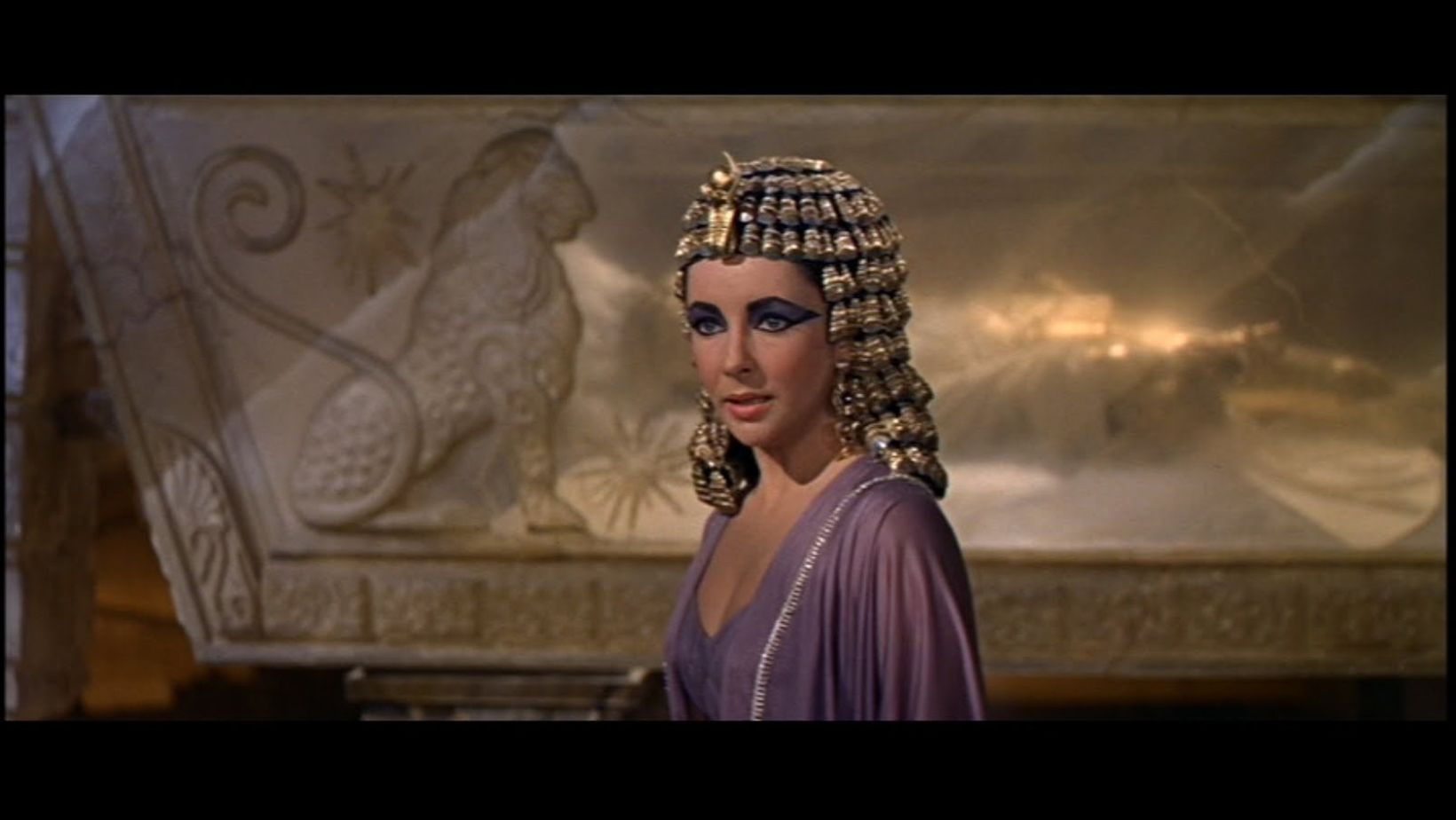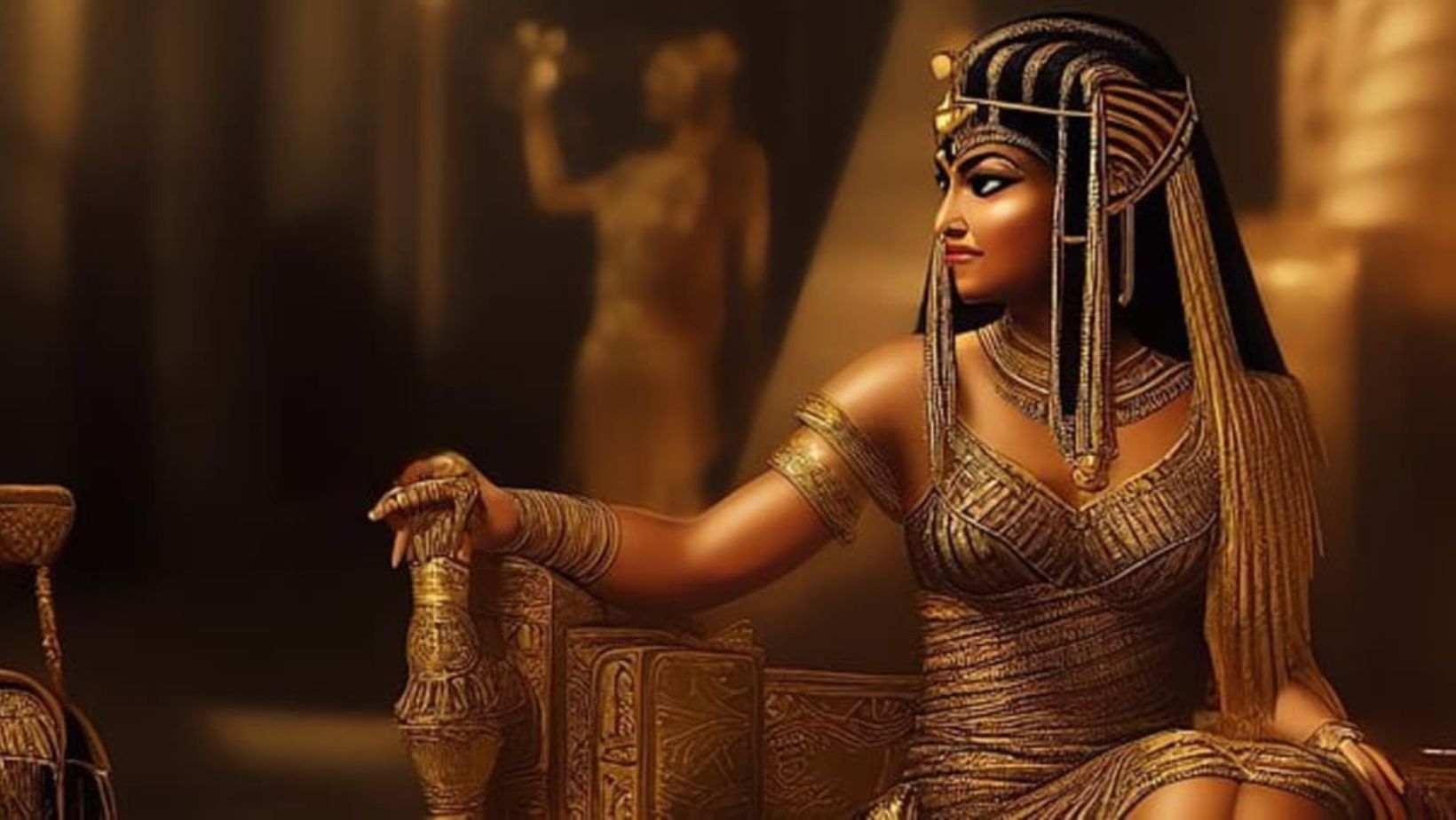Have you ever wondered what made Cleopatra, the last active ruler of the Ptolemaic Kingdom of Egypt, such an enduring icon in both history and style? It wasn’t just Cleopatra’s Fashion, political acumen, or storied romances with Julius Caesar and Mark Antony that captured our imagination. Her bold fashion choices are a big part of why she’s so unforgettable. From the majestic purple to luxurious linen garments, each element was a carefully chosen symbol of power and elegance.
The significance behind these sartorial decisions goes beyond mere vanity; they were strategic tools in asserting dominance and captivating allies and foes alike. But how exactly did she manage this feat? More intriguingly, can we draw inspiration from Cleopatra’s wardrobe for today’s fashion?
Table of Contents:
- The Color Purple: Cleopatra’s Signature Fashion Choice
- Linen: The Fabric of Choice for Egyptian Royalty
- Accessorizing Like a Queen: Cleopatra’s Iconic Jewelry
- Cleopatra’s Legendary Hairstyles and Makeup
- Cleopatra’s Fashion as a Political Tool
- Conclusion
The Color Purple: Cleopatra’s Signature Fashion Choice

When we think of Cleopatra, we often picture her draped in luxurious, vibrant colors—especially purple. But why was this hue so significant to the legendary queen of Egypt?
In ancient times, purple dye was incredibly rare and expensive to produce.
For the ancient Egyptians, the color purple held sacred meanings. It was associated with the gods, particularly Amen-Ra, the king of the gods. Purple was also believed to protect the wearer from evil spirits and bring good fortune.
Cleopatra, known for her intelligence and political savvy, understood the importance of using fashion to convey her status and authority. By wearing purple, she aligned herself with the divine and reinforced her position as a powerful ruler.
How Cleopatra Made Purple Her Own: Cleopatra’s Fashion
Cleopatra didn’t wear any shade of purple—she favored a deep, rich hue that became known as “Tyrian purple” or “royal purple.” This specific color was achieved through a complex dye process using the mucus of the Murex snail.
The queen truly embraced purple, making it her own by weaving it throughout her iconic style. She wore purple robes and cloaks and even had purple sails on her royal barge. Cleopatra’s love of purple was so well-known that the color became synonymous with her reign.Some historians believe that Cleopatra’s affinity for purple was also a clever political move.
Linen: The Fabric of Choice for Egyptian Royalty
While Cleopatra is famous for her love of luxury, her clothing was also practical for the hot Egyptian climate. Her go-to fabric? Linen is made from the fibers of the flax plant.
Linen was the most common textile in ancient Egypt, valued for its light weight, breathability, and durability. It was worn by everyone from peasants to royalty, but the quality of the linen varied greatly depending on the wearer’s social status.
Only the finest linen would do for Egyptian royals like Cleopatra. Their garments were made from soft, thin, almost transparent linen, which allowed for both comfort and style in the desert heat.
Besides looking good, linen had some pretty handy perks, too. Linen clothing was often embellished with gold thread, beads, and other decorations to signify the wearer’s wealth and importance.
Cleopatra’s Favorite Linen Styles: Cleopatra’s Fashion
One of Cleopatra’s signature looks was the kalasiris, a long, flowing linen gown that was cinched at the waist with a colorful sash or belt. This style was popular among Egyptian women of all classes, but Cleopatra’s kalasiris would have been made from the finest, most transparent linen available.
Another favorite style of Cleopatra’s was the Greek-inspired peplos, a rectangular piece of linen that was folded and pinned at the shoulders to create a sleeveless dress. She often wore her peplos with intricate gold jewelry and a royal diadem or crown.
Cleopatra’s love of linen wasn’t just about fashion – it was also a reflection of her Egyptian heritage and connection to her kingdom’s traditions. She rocked that age-old fabric, blending her personal flair with a nod to her roots in one stylish move.
Accessorizing Like a Queen: Cleopatra’s Iconic Jewelry
No discussion of Cleopatra’s fashion would be complete without mentioning her legendary jewelry collection. From massive gold necklaces to glittering rings and bracelets, the queen adorned herself with the ancient world’s finest treasures.
Cleopatra’s jewelry served several purposes. It displayed her immense wealth and power, showcased her impeccable taste, and was a tool for political maneuvering.
Statement Necklaces Fit for Royalty
One of Cleopatra’s most iconic jewelry pieces was her broad collar necklace, a wide, flat necklace made of gold, semi-precious stones, and glass beads. These necklaces often featured intricate designs and religious symbols, worn by both men and women of the upper classes.
Cleopatra was also known for her love of emeralds, which she reportedly wore in abundance. Some historians believe that many of her emeralds came from mines in southern Egypt, a region that she personally controlled.
Stacked Bracelets and Cuffs
In addition to her necklaces, Cleopatra was often depicted wearing stacks of gold bracelets and armlets. These ranged from simple bangles to elaborate cuffs adorned with precious gems and intricate designs.
Cleopatra’s bracelets weren’t just decorative – they also served as a form of portable wealth. In ancient times, jewelry was often used as currency, and the queen’s extensive collection was a tangible symbol of her riches and influence.
Recent jewelry discoveries from the period suggest that Cleopatra may have even worn arm cuffs high on her biceps, a bold and unconventional choice that showcased her daring fashion sense. By adorning herself in gold from head to toe, Cleopatra left no doubt about her status as a queen and a living goddess.
Cleopatra’s Legendary Hairstyles and Makeup
Cleopatra’s beauty secrets were as legendary as the queen herself. Her elaborate hairstyles and dramatic makeup have inspired countless imitations and adaptations over the centuries, from Hollywood films to haute couture runways.
But what did Cleopatra’s hair and makeup actually look like? We have a fairly good idea of the queen’s signature style thanks to ancient art, coinage, and historical accounts.
The Iconic “Melon” Hairstyle
One of Cleopatra’s most famous hairstyles was the “melon,” consisting of tight, sectioned curls that were pulled back into a low bun at the nape of her neck. This style was named for its resemblance to the ridged skin of a melon.
The melon hairstyle was more than just a fashion statement – it was also a nod to the Egyptian goddess Isis, who was often depicted with a similar coiffure. Cleopatra’s hair, in this manner, reinforced her divine status and connection to the gods.
Cleopatra’s hairstyles varied depending on the occasion and her audience. This adaptability was a hallmark of Cleopatra’s fashion sense as she skillfully navigated different cultural expectations and norms.
Dramatic Kohl-Lined Eyes
No image of Cleopatra is complete without her signature kohl-rimmed eyes. Kohl, a black powder made from ground minerals, was used by both men and women in ancient Egypt to line and define the eyes.
But Cleopatra took this traditional makeup to the next level, creating a dramatic, almond-shaped eye that became her trademark look. She likely used a combination of kohl, green malachite powder, and red ochre to create her striking eye makeup.
Kohl was believed to have medicinal and spiritual benefits in addition to its cosmetic purposes. It was thought to protect the eyes from the sun’s glare and ward off evil spirits, making it an essential part of Cleopatra’s beauty regimen.
Cleopatra didn’t just wear bold makeup to turn heads – it was her way of showing everyone who’s boss.
Cleopatra’s Fashion as a Political Tool

For Cleopatra, fashion was about more than just looking good – it was a key part of her political strategy. As a ruler in a male-dominated world, she used her clothing and appearance to assert her power, influence, and divine right to the throne.
Cleopatra’s fashion choices were carefully calculated to send specific messages to her subjects and rivals.
One of Cleopatra’s most famous fashion moments occurred when she first met Mark Antony in Tarsus. According to ancient historians, she arrived on a magnificent golden barge, reclining under a canopy of gold cloth and dressed as the goddess Aphrodite.
This grand entrance was designed to dazzle Antony and assert Cleopatra’s status as his equal (or even his superior). By presenting herself as a living goddess, Cleopatra made it clear that she was no ordinary queen – she was a force to be reckoned with.
Cleopatra’s fashion diplomacy didn’t stop there.
Using Fashion to Assert Power: Cleopatra’s Fashion
But Cleopatra’s fashion statements weren’t just aimed at impressing others—they were also a way to assert her own power and authority. By dressing in the finest fabrics and adorning herself with gold and jewels, she reminded her subjects of her wealth and status.
Cleopatra constantly switched up her style, keeping everyone from enemies to friends, always guessing what she’d do next. Her frequent costume changes and dramatic transformations were a way to keep all eyes on her, as she constantly reinvented herself and kept her audience guessing.
Some historians believe that Cleopatra’s fashion choices were also a way to distract from her political maneuverings and keep her enemies off balance. By creating a dazzling spectacle every time she appeared in public, she drew attention away from the machinations of court life and the challenges to her rule.
In the end, Cleopatra’s fashion legacy is inseparable from her political one.
Key Takeaway: Cleopatra’s Fashion
Cleopatra’s fashion use wasn’t just about style—it was a calculated part of her political arsenal. She projected wealth and divine authority by rocking luxurious purple and fine linen. Her bold makeup and jewelry choices further set her apart as a living goddess, making every outfit a statement of power.
Conclusion: Cleopatra’s Fashion
In exploring Cleopatra’s world through the lens of her iconic attire, we’ve stepped into a realm where every fabric choice whispered tales of sovereignty while jewelry pieces marked milestones not only within Egyptian borders but also on global stages then known to mankind.
This journey through ancient hallways draped in linen whispers and corridors echoing with steps taken by gold-adorned feet reveals one truth—although centuries have passed since those regal days beneath Egyptian suns saw their twilight, echoes resonate still within realms where designers seek muses among legends past.
Cleopatra’s legacy is woven deeply into fabrics far richer than mere cloth—it lives on as a testament to embracing personal style powerfully enough to become immortalized across eras. Her story tells us something vital about human nature itself; there exists no era nor empire wherein aesthetics fail to play crucial roles, defining identities both individualistic and universal simultaneously.

